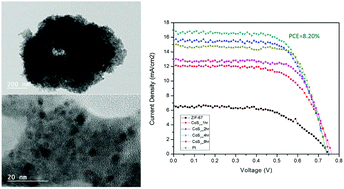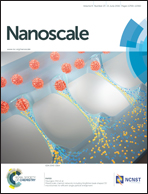Novel CoS2 embedded carbon nanocages by direct sulfurizing metal–organic frameworks for dye-sensitized solar cells
Abstract
Owing to its excellent electrocatalytic properties, cobalt disulfide (CoS2) is regarded as a promising counter electrode (CE) material for dye-sensitized solar cells (DSSCs). However, hindered by its relatively poor electrical conductivity and chemical instability, it remains a challenge to apply it into high-performance DSSCs. In this work, we have developed novel CoS2 embedded carbon nanocages as a CE in DSSCs, using ZIF-67 (zeolitic imidazolate framework 67, Co(mim)2, mim = 2-methylimidolate) as a template. The CoS2 samples sulfurized for different time lengths are prepared through a facile solution process. It is found that the sulfurization time can be optimized to maximize the DSSC efficiency and the DSSC based on the CoS2 embedded carbon nanocages sulfurized for 4 hours exhibits the highest photovoltaic conversion efficiency (PCE) of 8.20%, higher than those of DSSCs consisting of other CoS2 CEs and Pt-based DSSC (7.88%). The significantly improved DSSC PCE is contributed by the synergic effect of inner CoS2 nanoparticles and an amorphous carbon matrix, leading to a CE with high catalytic activity, good electrical conductivity and excellent durability. This study demonstrates that the CE based on inexpensive CoS2 embedded carbon nanocages is a prospective substitute to expensive platinum and provides a new approach for commercializing high-efficiency DSSCs.


 Please wait while we load your content...
Please wait while we load your content...